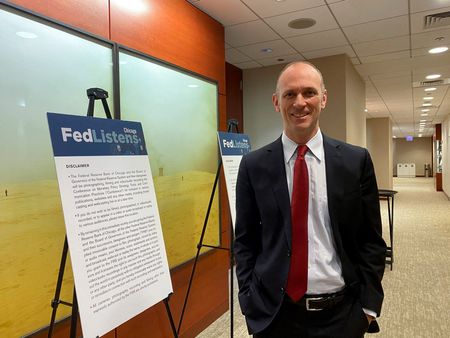By Howard Schneider
CHICAGO (Reuters) – Chicago Federal Reserve president Austan Goolsbee said that economic conditions will determine how fast the Federal Reserve cuts rates from here, but added he hopes the Fed will be homing in on a stopping point by the end of next year.
“I’m hopeful that conditions continue to evolve such that we can get in close to the range” where monetary policy is having a neutral impact on the economy, Goolsbee said in comments to reporters.
While he would not specify his estimate of neutral, he said that a level around 3%, well below the current 4.5% to 4.75% rate and roughly the median that Fed officials projected as a stopping point at their September meeting, “doesn’t seem crazy to me.”
The Fed is expected to cut interest rates by another quarter of a percentage point at its upcoming Dec. 17-18 meeting, and also update policymakers’ projections of where they see the economy and rate policy heading next year.
Goolsbee, who will be a voter on interest rate policy in 2025, laid out his views in an interview with journalists at the Chicago Fed, describing an economy that he feels is at or close to full employment and expected to make progress to the Fed’s 2% inflation target.
It is a situation where he said the Fed could continue to cut rates at a gradual pace as officials watch the evolution of the economy and settle on a stopping point.
At this point he said it would take an unexpected jump in inflation or a surprise tightening of the job market to push the Fed in a different direction, he said.
“For us to get off the path that I envision over the next year, conditions would have to change on either or both…Inflation looks like it’s not heading to 2%, the job market looks like the economy’s overheating,” Goolsbee said.
A new report showing U.S. firms added 227,000 jobs in November reaffirmed for many analysts that the economy has largely returned to normal from the excesses of the pandemic era, with an unemployment rate that Fed officials regard as at or close to full employment, and average monthly job coverage hovering around where it was in the decade before the pandemic.
The job market “is in better balance and in kind of a steadier state,” Goolsbee said, anticipating that the Fed will have “a series of close meetings” in coming months over how much further and how fast to reduce the benchmark policy rate.
Goolsbee also said he was coming to have more faith that a recent rise in labor productivity may prove persistent. He said such a development would add confidence to forecasts of slowing inflation, could raise U.S. growth potential, and potentially ease the impact of labor constraints that might develop because of population aging or tougher immigration rules.
“We have to start taking seriously the idea that this thing is continuing,” Goolsbee said, and the implications it could have for monetary policy.
“There are business people who say…it’s been so hard for them to hire. They’ve put in machines. They’ve done labor-saving technologies precisely because they couldn’t find people,” Goolsbee said. “I do think on the ground, there’s some evidence,” with a possibility that those sorts of technological or management changes could spread successively through different industries.
(Reporting by Howard Schneider; Editing by Chizu Nomiyama)
